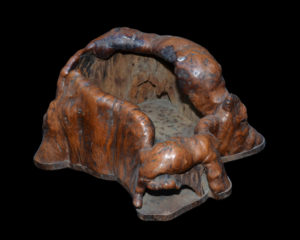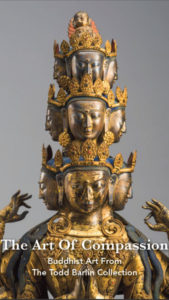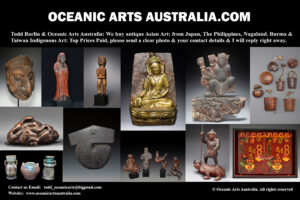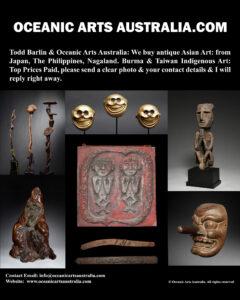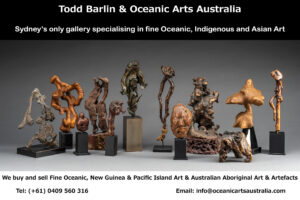A Fine Old Japanese Natural Burlwood Hibachi or Hand Warmer
| Collection No. | SOLD but see lots more Fine Oceanic & Aboriginal Art on my website |
|---|---|
| Size | Length 33cm x Width 28cm |
A Fine Old Japanese Natural Burlwood Hibachi or Hand Warmer
This beautiful old Japanese Hibatchi or Hand Warmer is made from a natural burl form with an inward curved lip like a wave, usually inside there was a copper lining now missing, the whole is mounted on a thick flat cedar base. Hibachi were traditionally used during Tea Ceremonies and as a source of heat in the winter months. This Hibatchi is dating from the late 19th Century.
The Japanese word for the tea ceremony, chanoyu, literally means “hot water for tea,” the practice involves much more than its name implies. Chanoyu is a ritualized, secular practice in which tea is consumed in a specialized space with codified procedures. The act of preparing and drinking matcha, the powdered green tea used in the ceremony, is a choreographed art requiring many years of study to master. The intimate setting of the tea room, which is usually only large enough to accommodate four or five people, is modeled on a hermit’s hut. In this space, often surrounded by a garden, the participants temporarily withdraw from the mundane world.
In the tea room, the emphasis is on the interaction between the host, guests, and tea utensils. The host will choose an assemblage of objects specific to that gathering and use those utensils to perform the tea preparations in front of the guests. Each tea gathering is a unique experience, so a particular assemblage of objects and people is never repeated. The guests are expected to abide by tea room etiquette with regard to the gestures used to drink the tea and the appreciation of the utensils. When presented with a bowl of tea, a guest will notice and reflect upon the warmth of the bowl and the colour of the bright green matcha against the clay before he begins to drink.
The ceramics used in this context—tea bowls, water jars, flower vases, tea caddies and hibatchi are functional tools valued for their practicality as well as artworks admired for their aesthetic qualities. A key element in this practice is the host’s connoisseur-ship skills; the host acquires a collection of objects that conform to a shared aesthetic standard and selects which objects to use in a particular gathering.
The natural wood form is Wabi-Sabi . In Zen philosophy there are seven aesthetic principles for achieving Wabi-Sabi as listed below;
Fukinsei (不均斉): asymmetry, irregularity;
Kanso (簡素): simplicity;
Koko (考古): basic, weathered;
Shizen (自然): without pretence, natural;
Yugen (幽玄): subtly profound grace, not obvious;
Datsuzoku (脱俗): unbounded by convention, free;
I bought this object because I knew right away that I would never get tired of looking at it or touching the warm beautiful wood.
Provenance: The Todd Barlin Collection of Asian Art & Buddhist Art
INQUIRE HERE
To see many more rare items and the finest masterpieces, please make an appointment with us to visit the gallery.
For all inquiries, please contact us.

